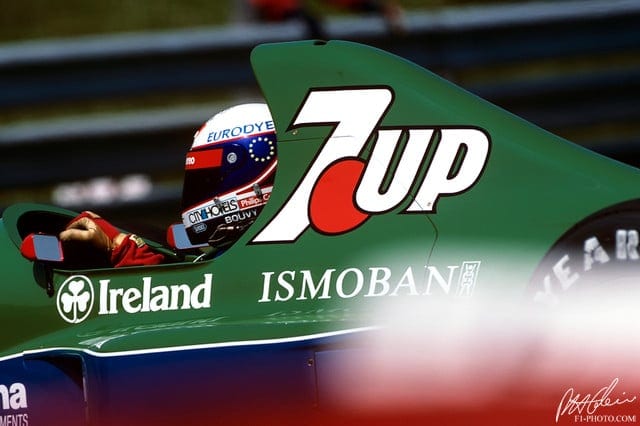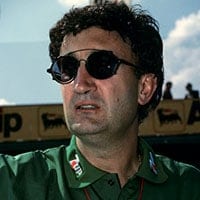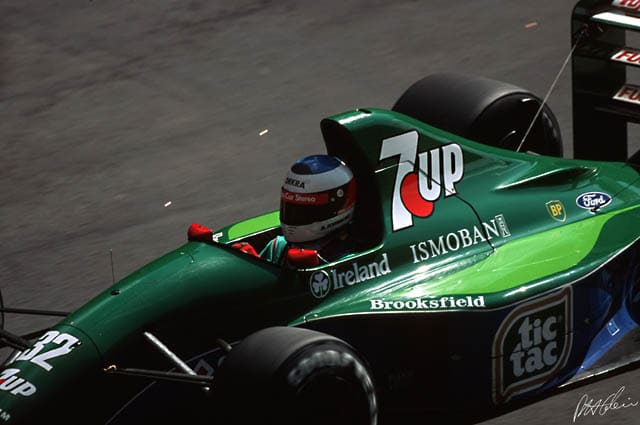A quarter of a century ago, one driver’s mistake opened the door for the beginning of a legend.Jaap Grolleman explains the story of Bertrand Gachot, Michael Schumacher and the 1991 Belgian Grand Prix.
Twenty five years ago, the paths of two promising talents intertwined. The career of the one who seemed destined for greatness halted, while that of the unknown sparked and ignited into an even bigger greatness. It then seemed an unfortunate matter of circumstance, but connecting the dots in hindsight, the month of August 1991 was monumental in the era of modern Formula One.
The Belgian
Bertrand Gachot, a twenty-eight-year-old Belgian, finally got his Formula One act together in the summer of 1991, after two miserable seasons with Onyx and Colini. The Luxembourg-born Gachot was still considered a hot prospect after impressing in his two rookie seasons in British Formula Three and Formula 3000.
In his third Formula One season he drove the Jordan 191, designed by Gary Anderson, which was a beautiful and nimble machine. After the Irish team, fresh to the sport, solved its reliability issues, Andrea de Cesaris and Gachot started to reel in points regularly from the fifth race onwards. Gachot was almost in the top ten of the standings, and between the German and Hungarian Grand Prix he won the 24 Hours of Le Mans, together with Johnny Herbert and Volker Weidler.
At the Hungarian Grand Prix of the season – in a field that included Ayrton Senna, Nigel Mansell, Alain Prost, and Nelson Piquet – the young Belgian raised more praise, as he snatched the fastest lap of the race.

Gachot in Hungary, 1991 – Copyright © The Cahier Archive
Gachot’s star seemed on the rise, but he had already ruined his chances the previous year, yet neither him or anybody else knew about it.
In December of 1990 on London’s Hyde Park Corner, a taxi driver by the name of Eric Court filtered through traffic, until he collided with an Alfa Romeo. Behind the wheel was Bertrand Gachot, with his girlfriend in the passenger seat. It was a minor accident, but a heated debate followed. Gachot grabbed his CS gas canister as a repellent, but when Court came closer, the canister was discharged on Court’s face. For Gachot it was a clear case of self defence and he didn’t think much of it. That was until the matter went to court in between the Hungarian and Belgian Grand Prix of 1991. The judge ruled harshly, and Gachot was sentenced to two years in prison.

Eddie Jordan, 1991 – Copyright © The Cahier Archive
Eddie Jordan, who was on a tight budget with his team, was suddenly without a driver for the #32 machine. Because Gachot’s verdict was smeared all over the press, the vacancy for the promising team was well known.
It was rumoured that Keke Rosberg was interested, and Stefan Johansson and Derek Warwick were considered. Yet all three wanted payment, so Jordan looked elsewhere. A young Brit named Damon Hill was also in the frame for the seat.
The German
In an alternative storyline in that 1991 Le Mans Race, a Mercedes powered Sauber prototype car was driven to fifth place, with the team of Karl Wendlinger, Heinz-Harald Frentzen and Michael Schumacher behind the wheel. Schumacher had achieved success in German Formula Three, but had taken the unconventional route towards Formula One via prototype racing, and thus the young German was relatively unknown.
As soon as Gachot’s verdict was delivered, Schumacher’s manager, Willi Weber, was on the phone with Eddie Jordan. Jordan was interested – especially when it appeared the Schumacher could bring money – but also voiced concerns. This was Spa after all; the longest and most challenging circuit of the calendar, and Schumacher had never driven a Formula One car. Jordan asked Weber whether Schumacher had ever driven any car at Spa, which Schumacher hadn’t. Weber didn’t lie exactly, but merely deflected the question: “He’s born and brought up only fifty miles away from the track, what do you think?”
Jochen Neerpasch, Mercedes’ motorsports manager, brought forward the £150,000 needed for Schumacher’s one-off drive, with help from sponsors Dekra and Tic Tac. Neerpasch was already planning to go to Formula One with Sauber, with Mercedes supplying the engine, and he desperately wanted a talented German to drive it.
The deal was done and Schumacher tested the 191 on the south variant of the Silverstone track. Within a few laps, Schumacher matched the pace of the regular drivers. The team brought him in, urging him to slow down to not have a crash. Schumacher replied he wasn’t pushing at all. When Schumacher was sent out again, Trevor Foster, the team manager, turned to commercial manager Ian Phillips and said, “Phone Eddie, and tell him we’ve found a star.”

Schumacher in the Jordan 191 – Copyright © The Cahier Archive
The Belgian Grand Prix of 1991
While Gachot was sent to the high-security Brixton prison, Schumacher arrived at Spa. Jordan’s lead driver Andrea de Cesaris would show the twenty-two year old around the track, to show the braking points, the racing lines, etc. But when it appeared the Italian wasn’t going to make time for, Schumacher borrowed a mountain bike and did two laps around the circuit to learn it himself.
On Friday, the Belgian Formula 3000 driver Pascal Witmeur, feeling the penalty was too harsh, started the ‘Free Gachot’ campaign. There were flags, posters and t-shirts, which many drivers, including Alain Prost, wore around the paddocks. On several places on the track, fans sprayed graffiti messages of support for Gachot on the circuit.

Schumacher, 1991 – Copyright © The Cahier Archive
That was one tale of Friday. The other was about Schumacher, who had slept in a youth hostel because no accommodation was provided by Jordan. As soon as he was in the Jordan, the paddock was transfixed on the timing screens. Schumacher eclipsed De Cesaris and ended the day as the fastest Jordan driver, eight fastest overall. And in Saturday’s qualifying, Schumacher was over half a second faster than De Cesaris, with a neat seventh place.
Jordan’s Mark Gallagher stated: “Obviously, de Cesaris is no slouch, but for Michael to arrive at a driver’s circuit like Spa and do such a good job, that’s terrific.” De Cesaris was furious: “There must be something wrong with my car.” But there was nothing wrong with the car. Come Sunday, it was Schumacher’s car who failed, as the German retired after two corners with a broken clutch. By then, he had already passed Jean Alesi and Nelson Piquet.
Michael Schumacher had arrived.

Total focus from Schumacher – Copyright © The Cahier Archive
The Aftermath
Schumacher only had a contract for one race, but landed a seat at Benetton for his stellar performance at Spa, ousting Roberto Moreno, who took the vacant Jordan seat. Schumacher took points in Italy, Portugal and Spain, ending the season in fourteenth place, one behind Gachot.
Schumacher’s old team of Sauber, with Mercedes engines, reached Formula One in 1993, achieving respectable results. By then Schumacher was already a race winner and not seeking a midfield drive. Instead, nineteen years and seven titles later, and arguably well beyond his prime, Schumacher would finally drive for Mercedes, claiming a single podium in three seasons.
Bertrand Gachot was released from prison two months after the sentence, as another judge ruled the original sentence to be too harsh. But the damage to his career had been done. Gachot entered the final race of the season with Larrousse but failed to qualify. In 1992 he drove for Venturi, taking one more point scoring finish in Formula One, before racing for the start-up Pacific team in 1994 and 1995.
Gachot focussed on business and marketing after his Formula One career and is now the owner of Hype, an energy drink. Years later, Gachot eventually returned to Jordan; the team was then named Force India, and Gachot no longer a driver, but a sponsor.
Gachot once said of the weekend; “The whole situation was quite an experience as a human being. To find oneself in prison was mentally incredible and it made me stronger as a person. I told myself that once I would be out, I would enjoy every day of my life. As long as me and my family were free and in good health, I would complain about nothing. I learned a lot from it and tried to take the positives from a negative situation. Don’t get me wrong, I’d have preferred to have been at the Grand Prix! I bet that I’d be on pole for the race at Spa. But that’s how it was, and that’s how it is.”